|
End of Menu Items |
My life with Y 7171 
My life with the Y-Type started in 1968 when my Standard 8 was taken for its annual test and there on the ramps in the garage was MLN420, a little tatty but I was taken. Talking to the garage owner he said he had taken it in part exchange for a car he sold but would have to sell it on in London. "What would it fetch?" I asked, "£35" he said and £25 later it was mine and that was 1968. 45 years later I sold it and this is the story of the golden rivet in the years in between.
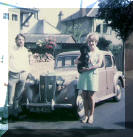 The garage said it was a bit "endy", meaning the engine needed a rebuild I deduced, but being a lowly paid lab assistant this meant I had to do it myself. A small problem — I knew nothing of the workings of the automobile but I reasoned if a garage mechanic could do it then so could I and all I had to do was learn how. Accordingly I visited the local library and borrowed six books on the theory of engines and purchased a copy of Blower. Then came the hard part — we had no garage just a lock up without power rented down the street. "Darling", I said to my wife "how would you feel if... ." and the result of negotiations was that 2 inches of newspaper on the dining room table would allow the rebuild to proceed in the dining room. The engine came out and into a wheelbarrow (in those days I could lift an XPAG) and through the French doors, into the dining room and up onto the table. I rebuilt it with new shell bearings, cam bearings and pistons and then was ready to refit it and run in the engine. Now even then, I was not one for pootling around at 30mph so with supreme confidence I traced a route of 250 miles out and 250 miles back, and off my wife, I and the dog went. Amazingly this engine had no teething problems and bingo it was run in.
The garage said it was a bit "endy", meaning the engine needed a rebuild I deduced, but being a lowly paid lab assistant this meant I had to do it myself. A small problem — I knew nothing of the workings of the automobile but I reasoned if a garage mechanic could do it then so could I and all I had to do was learn how. Accordingly I visited the local library and borrowed six books on the theory of engines and purchased a copy of Blower. Then came the hard part — we had no garage just a lock up without power rented down the street. "Darling", I said to my wife "how would you feel if... ." and the result of negotiations was that 2 inches of newspaper on the dining room table would allow the rebuild to proceed in the dining room. The engine came out and into a wheelbarrow (in those days I could lift an XPAG) and through the French doors, into the dining room and up onto the table. I rebuilt it with new shell bearings, cam bearings and pistons and then was ready to refit it and run in the engine. Now even then, I was not one for pootling around at 30mph so with supreme confidence I traced a route of 250 miles out and 250 miles back, and off my wife, I and the dog went. Amazingly this engine had no teething problems and bingo it was run in.
I now used it to commute to London and back each evening about 35 miles each way and soon felt the need for more power to keep the 1600 Ford Cortinas in their place. It was also at about this time that I joined the MG Car Club and learnt a bit about tuning so taking a grind stone to the inlet manifold and buying a 1.5inch SU from the scrap yard, led to more power and the need to carry a 4 ft length of steel rod in the boot and a spare half shaft. The Jackal system came into it's own on my commutes and I found I could change a half shaft in a few minutes — much to the amazement of the forecourt attendant that I cruised to a stop in front of.
 It was in this stage of tune that I started racing. A group of 6 of us at the Danbury natter decided we should all start racing and so descended on the 1972 MGCC Silverstone meet when I carried off a high speed trial special award and last place in the T register race. But the bug bit and at the suggestion of Gordon Cobban, then general secretary of the club, toddled off in my lunch hour to talk to Dick Jacobs who had raced a Y—Type with factory support. He gave me several ideas and disclosed that when he ran his XPAGs up on the bench they often saw flames leaping from the (silvered tin) head gaskets!
It was in this stage of tune that I started racing. A group of 6 of us at the Danbury natter decided we should all start racing and so descended on the 1972 MGCC Silverstone meet when I carried off a high speed trial special award and last place in the T register race. But the bug bit and at the suggestion of Gordon Cobban, then general secretary of the club, toddled off in my lunch hour to talk to Dick Jacobs who had raced a Y—Type with factory support. He gave me several ideas and disclosed that when he ran his XPAGs up on the bench they often saw flames leaping from the (silvered tin) head gaskets!
There then followed a few years when I battled with T- racers and the bank manager until we settled into an uneasy truce when he accepted that all the overdraft I built up in the summer would be repaid over the winter. Thus I was able to enter events every 2 weeks and learnt to drive the car. The battle with the T racers was less successful, though more enjoyable and last place became the norm. The car was road tested by Glyn Guisti the then competions secretary and written up in the hilarious T racer newsletter where I was nicknamed "Super Y". The road test started "On entering the car one is assailed by the smell of rotting carpets"! It became clear he was biased against the car when he complained that he skinned his knuckles on the dashboard when engaging 1st gear.
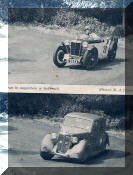 As the season progressed it became clear that the handling would have to be improved. Cornering at Woodcote with the inner rear wheel 6 inches in the air while I waved at friends beside the circuit, appealed to the commentator but was not fast. Indeed the August 1973 Safety Fast Wiscombe report included the statement "Barry Lacey-Malvern came up complete with tie and erect windscreen and Frank Vautier put his YA around the hairpin in the usual mimicry of a dog at a lamp post!" Barry Simons was the regular Silverstone commentator and always gave commentary out of all proportion to my race position. It was he who christened the car the fastest pound of Brussels Sprouts after I confided on my commentator's information sheet that we drove to the circuit and used the car for shopping trips. I also happened to mention I was a founder member of the Barry Simons fan club but I am sure this did not influence his judgement. The deficiency of this cornering mode was shown at the Sawbench corner at Wiscombe hill climb when I rolled.
As the season progressed it became clear that the handling would have to be improved. Cornering at Woodcote with the inner rear wheel 6 inches in the air while I waved at friends beside the circuit, appealed to the commentator but was not fast. Indeed the August 1973 Safety Fast Wiscombe report included the statement "Barry Lacey-Malvern came up complete with tie and erect windscreen and Frank Vautier put his YA around the hairpin in the usual mimicry of a dog at a lamp post!" Barry Simons was the regular Silverstone commentator and always gave commentary out of all proportion to my race position. It was he who christened the car the fastest pound of Brussels Sprouts after I confided on my commentator's information sheet that we drove to the circuit and used the car for shopping trips. I also happened to mention I was a founder member of the Barry Simons fan club but I am sure this did not influence his judgement. The deficiency of this cornering mode was shown at the Sawbench corner at Wiscombe hill climb when I rolled.
 Now the problem with hill climbs and sprints is that after the first run you have to decide how much faster you can corner next time. I found I could not take Sawbench hairpin flat in second and the car fell onto its roof. I sat there dangling from my seat belts in the mangled car when I saw the radiator cap about to touch the road surface. Oh no I thought, it will damage the chrome. We then pushed the car back upright and I finished the climb and after a bit of work on the gutters to allow the left hand door to open I managed two more season runs. After the meeting with the addition of gaffer tape on the sunroof my wife and I drove off on holiday to Wales together with friends in their VA. Back home I stripped out the roof lining, jacked the car up on its jacks and built a frame inside the roof supported from the garage floor, let down the jacks and bingo the car weight pushed the roof back into shape. Another endorsement of the strength of the Y—Type.
Now the problem with hill climbs and sprints is that after the first run you have to decide how much faster you can corner next time. I found I could not take Sawbench hairpin flat in second and the car fell onto its roof. I sat there dangling from my seat belts in the mangled car when I saw the radiator cap about to touch the road surface. Oh no I thought, it will damage the chrome. We then pushed the car back upright and I finished the climb and after a bit of work on the gutters to allow the left hand door to open I managed two more season runs. After the meeting with the addition of gaffer tape on the sunroof my wife and I drove off on holiday to Wales together with friends in their VA. Back home I stripped out the roof lining, jacked the car up on its jacks and built a frame inside the roof supported from the garage floor, let down the jacks and bingo the car weight pushed the roof back into shape. Another endorsement of the strength of the Y—Type.
It was at this point that we took a couple of trips to the Hausach rally in the Black Forest, Germany. The first one we made a weekend trip, leaving work on Friday night for the cross channel ferry and then driving via the cheapest petrol countries to arrive at Hausach in the small hours of the morning to find Gerhard's orchard, where we were to camp, in pitch black. We set up our tents only to find we were bit in the way and had to move at first light. The rally was fantastic, the barbeque put Silverstone to shame and the beer was very strong. I remember leading the British singers in competition with the Dutch singers with the backing of an oompah band in the marquee, and I remember waking up outside in the rain in the early hours. Sunday was a scenic drive followed by an overnight dash for the channel and straight to work on Monday morning after a trip to Toulmin Motors to buy a new hub and studs. Oh yes I forgot to mention on the dash back to the channel we sheared two wheel studs and stretched the others on one wheel. We stopped on a Belgian gentleman's driveway and the good old jackal system came good. With one stud taken from each of the other wheels we made up five on the bad wheel and left the others with 4.
 Over the years I then set about improving the handling and performance of the car, twin carbs was an early change together with higher compression ration, stiffer front springs and weaker rear springs. I first weakened the springs by progressively removing a leaf at a time until it dragged on the drive, then put one back. Eventually this led to a fundamental change in its cornering aspect until it now lifts a front wheel in extreme cornering.
Over the years I then set about improving the handling and performance of the car, twin carbs was an early change together with higher compression ration, stiffer front springs and weaker rear springs. I first weakened the springs by progressively removing a leaf at a time until it dragged on the drive, then put one back. Eventually this led to a fundamental change in its cornering aspect until it now lifts a front wheel in extreme cornering.
I still had the problem of half shafts though and in the early 70's these were unobtainable so I fitted an MGA rear axle that was a bit tight between the rear wheel arches and then a MG ZA axle which was a bit wider. This led to an interesting race at Cadwell park when the imbalance between front 16 inch YA braking and 15 inch ZA rear braking led to some hairy moments. The bank manager was generous and MGA front disc brakes were fitted which led to equal braking and reasonable handling. Now though I need more power so I bought a Shorrocks supercharger which gave more power but was a bit disappointing. It did though highlight the weakness of the ventilated disc ZA wheels they cracked around the disc from the ventilation holes and one cracked two thirds of the way around the wheel and made very strange noises coming round Woodcote corner at Silverstone. I managed to buy a set of 15inch minlites which with a bit of machining by George Edney adjusted the wheel nut centres to fit and are still on the car.
Work intervened and I was sent to the colonies to help our Australian subsidiary get uranium out of the ground, a fascinating job working in the bush but led to withdrawal symptoms from racing. Years later I returned to the UK and entered the Baitings Dam hill climb. Now you are supposed to walk the course and get your signature at the top so you are familiar with the route before you set off. But it was raining ... hard, so I left the paddock and walked the top half of the course. Come the first practice run it was still raining and I really got off the line well and was congratulating myself as I got round the first hairpin on the bottom half of the course and was looking for the finish. Oops! The finish was another hairpin away on the top half of the course; I couldn't brake hard enough and left the track on the hairpin going through the fence into the paddock — much to the consternation of the open wheeler that I just missed.
The only other potentially serious accident I had in this period was at the Prescot Bugatti Owner's Club hill climb. The last bend at the top of the circuit is called The Semicircle. I asked my fellow drivers if it's actually a semi circle. "Yes" they said. And off I set on my first practice run. I saw the start of The Semicircle and set the car in nicely within my limit. It was not a semicircle but turned sharp right half way round. I was going too fast and left the circuit and plunged down a very steep grassy hill with woods at the bottom. I was trying to plan a route to drive between the trees when the car picked up a wire fence half buried in the grass and after pulling out several fence posts, stopped. The car was fine but the forces were enough to allow the arm from the steering rack to deflect enough to break the rack casing end. There is normally around 8mm clearance here!
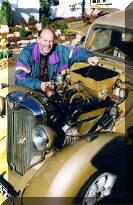 Over the next few years I experimented with high compression (12:1) tuning and a second Shorrocks supercharger but then I had a chat with John Bibby. We decided a big blower was the answer since the Y needs lots of low down torque. I didn't want a modern blower since it seemed out of place in period racing and settled on a pre-war Marshall J100 blower. I built a 1350 engine and John set to work and designed a novel installation with the blower on the left of the engine feeding an intercooler in the battery box and blowing through a 2 inch SU cab into the inlet manifold. The dynamo was moved to the right hand side just above an external water pump both driven by the fan belt. We also changed the Y-Type gearbox for a TC type box (actually from an early Riley RMA). The car with this engine we took to Mallory Park circuit to set up and had fun filing 0.125 inch needles to give something close to right and then took it to the rolling road where it showed 134bhp! A bit up on the original 46! Another amazing fact the car drove up onto the trailer on tickover — that's torque! At this stage I also fitted a full harness seat belt to replace the lap and diagonals I had fitted years before. The upper mounting point on the door pillar was always a bit too far forward for comfort. This meant I couldn't keep the rear seat squab in place since I reinforced the body plate behind the squab and mounted the belt pickup points there, the rest of the original interior trim I kept in the car for appearance sake although I could have saved a few pounds by stripping it out.
Over the next few years I experimented with high compression (12:1) tuning and a second Shorrocks supercharger but then I had a chat with John Bibby. We decided a big blower was the answer since the Y needs lots of low down torque. I didn't want a modern blower since it seemed out of place in period racing and settled on a pre-war Marshall J100 blower. I built a 1350 engine and John set to work and designed a novel installation with the blower on the left of the engine feeding an intercooler in the battery box and blowing through a 2 inch SU cab into the inlet manifold. The dynamo was moved to the right hand side just above an external water pump both driven by the fan belt. We also changed the Y-Type gearbox for a TC type box (actually from an early Riley RMA). The car with this engine we took to Mallory Park circuit to set up and had fun filing 0.125 inch needles to give something close to right and then took it to the rolling road where it showed 134bhp! A bit up on the original 46! Another amazing fact the car drove up onto the trailer on tickover — that's torque! At this stage I also fitted a full harness seat belt to replace the lap and diagonals I had fitted years before. The upper mounting point on the door pillar was always a bit too far forward for comfort. This meant I couldn't keep the rear seat squab in place since I reinforced the body plate behind the squab and mounted the belt pickup points there, the rest of the original interior trim I kept in the car for appearance sake although I could have saved a few pounds by stripping it out.
The first race after that was memorable, I gained six rows of the grid from the start and left two strips of black rubber on the tarmac according to the Jowett Jupiter driver behind me. Of course over the next few laps most of the six rows passed me again — too many corners — but I still finished in the middle - an unprecedented result that pleased me greatly. This engine proved to be supremely reliable despite its extreme tuning, largely I think due to the cooling of the charge —the inlet temperature of the engine was typically 360 degrees C. We had good results over a number of meetings until the fateful Bentley drivers club Silverstone. In my defence I was distracted by a small radiator overflow leak that was spraying the windscreen and a bonnet catch not properly fixed but as I attempted to overtake Paddy Wilmer in his full race TA around the outside on the entry to Luffield corner the back end broke away and I didn't catch it early enough to prevent a lurid barrel roll. The Autosport magazine photographer,  managed to take six shots of the roll in progress and the car ended up on its side having bounced gracefully on each side of the roof. At this stage I began to get a bit worried because none of the doors or the sun roof would open. Fear lent me strength and I got the top front door open and climbed out to find the race had been stopped.
managed to take six shots of the roll in progress and the car ended up on its side having bounced gracefully on each side of the roof. At this stage I began to get a bit worried because none of the doors or the sun roof would open. Fear lent me strength and I got the top front door open and climbed out to find the race had been stopped.
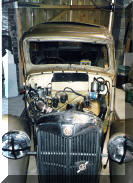 This time it took a little more effort to get the body back because the shell had lozenged so the body jacks had to come out, even so it was back ready for MG Silverstone just 4 weeks later.
This time it took a little more effort to get the body back because the shell had lozenged so the body jacks had to come out, even so it was back ready for MG Silverstone just 4 weeks later.
This was to be my last race and I am often asked why. There were many reasons and I am not sure myself which was the final straw, I had been thinking of stopping for some time. I had retired from work and had less cash, the drivers that I started racing with 40 years before were largely not racing, the social scene of down the pub for a pint of beer at lunchtime after practice and after the race was no more, we had moved to Wales which was a long way from the circuits, and I had a TA which I wanted to trial but could not find their time when racing.
In any case I made the decision, stopped and now I am campaigning the TA a few times a year in the MG car club trials. In this car I am at least competitive and with my wife as navigator even managed to win the Kimber classic trial a couple of years ago.
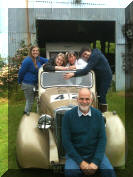 As for the Y-Type I have now sold it to Graham Meyer who plans to compete in it in sprints and hill climbs in Jersey and northern France, so the golden rivet lives on.
As for the Y-Type I have now sold it to Graham Meyer who plans to compete in it in sprints and hill climbs in Jersey and northern France, so the golden rivet lives on.
Perhaps just to finish — the golden rivet was christened at a sprint at Duxford airfield in the early 70's when my seat frame broke and I repaired it in the paddock using pop rivets. For those not familiar with British naval parlance new recruits were invited to bend down to inspect the golden rivet that was reputedly fitted in a low point of the old riveted ships. Probably not a politically correct thing to do these days.

